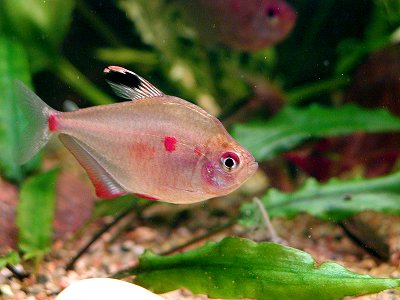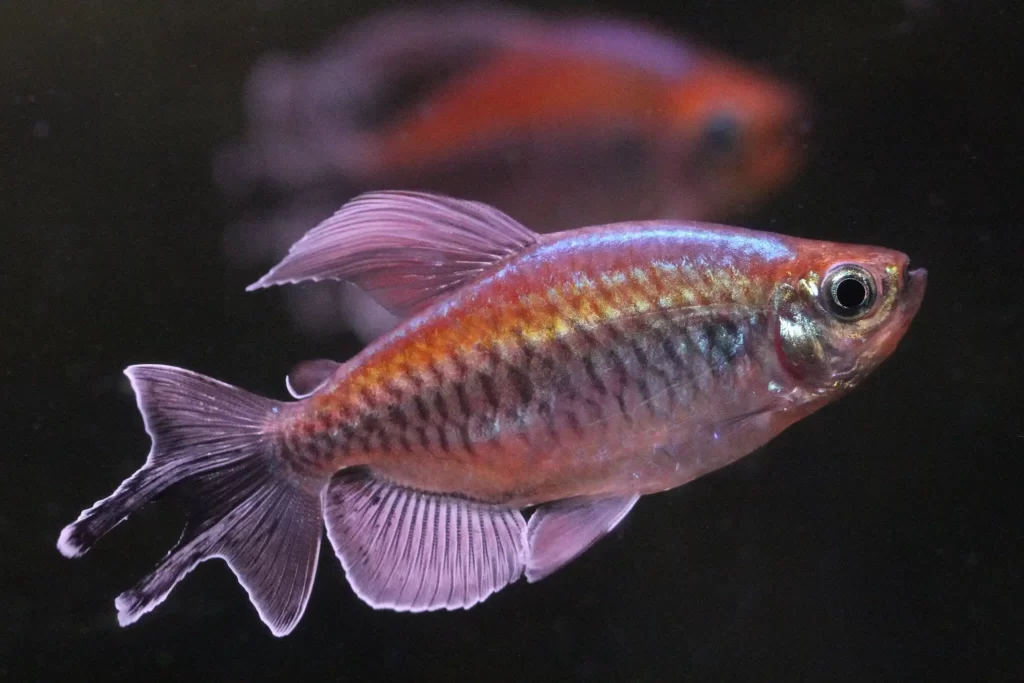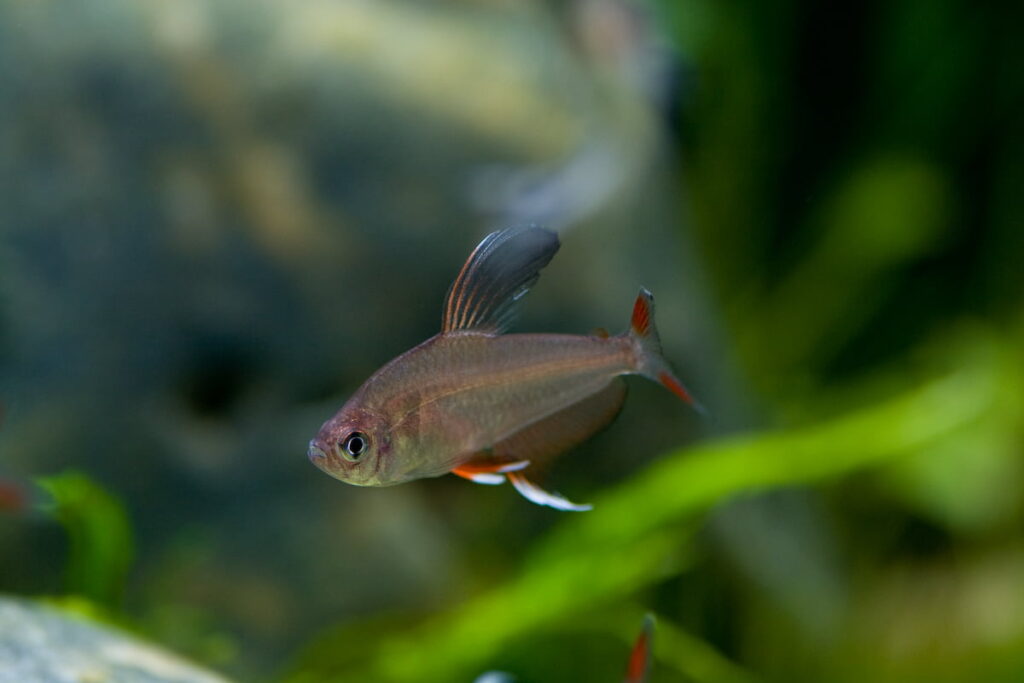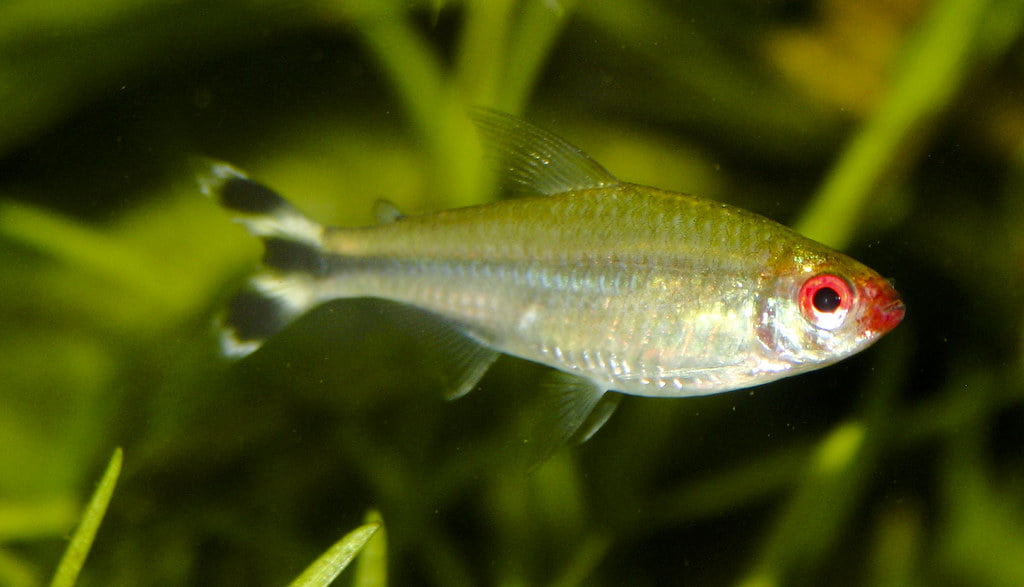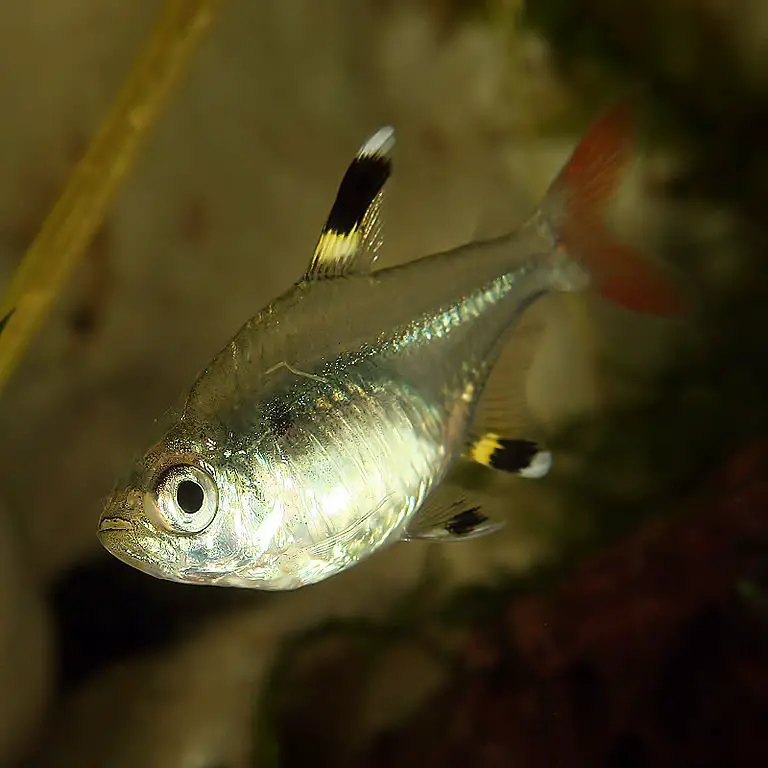Tetra fish has a big family including around 700 known members, and there is a chance some tetras are yet to be discovered. Even with these big family members, each of them has small differences with unique features making them exclusive. The bleeding heart tetra is one of the family members of the tetra family and as the name suggests has a unique feature.
Bleeding Heart Tetra has a marking-colored blushing red near its gills making it look like the fish has a bleeding heart. The scientific name of bleeding heart tetra is Hyphessobrycon erythrostigma but it has other common names too viz. Spotfin Tetra and Tetra Perez.
The colors of the bleeding heart tetra range from beige-orange to silvery lavender and these colors brighten when they feel the most secure. The bleeding hearts, like other tetras, are schooling fish and therefore kept with small groups of their kind.
You will know more about the bleeding heart tetra in detail in this article. Keep reading to gain more insights about the origin, care, and tank environment one must know if s/he is planning to keep them as a pet.
Origin, Habitat in the Wild and Distribution
Bleeding Heart Tetras are very common aquarium fish since they are unique and easy to handle. But don’t you want to know where they are originally from?
Bleeding heart tetra is native to the densely populated streams and banks of the Upper Amazon. These tetras are also found on river basins in South America and Columbia and Fowler first described them in 1943.
Bleeding hearts prefer water areas that are deeper and shallower. You can find them mainly in slow-moving streams.
These tetras are a fan of overhanging plants, in the form of fallen branches and roots, along with aquatic vegetation and submerged wood.
Since the IUCN Red List has not listed the bleeding heart tetras, and hence they are/were primarily collected from the wild.
However, today, they are commercially bred and are exported to many countries around the globe.
About Bleeding Heart Tetra
If you want to keep bleeding heart tetra as a pet then they will surely be the major attraction for your aquarium.
Tetra fish are active schooling fish and bleeding hearts are one of them. Meaning they swim in a group creating a spectacular view in your tank.
Bleeding heart tetras are species of tropical freshwater fish and are the most suitable fish even for beginner aquarists. A person with basic knowledge about fish keeping can easily pet them in their aquarium happily.
The fish has a blooming red spot on their gill, which recognizes as its heart and hence their name.
Let us get into more details about the bleeding heart tetras including their appearance, lifespan, availability, etc.
Appearance Of Bleeding Heart Tetra
The tetra family fish are of various shapes and sizes with unique features. As mentioned earlier, the bleeding heart tetra’s most exclusive feature is its bright red patch on the side that looks like a bleeding heart and hence its name “Bleeding heart tetra.”
The body of bleeding heart tetra is very deep and the color range can be from beige-orange to silvery lavender.
If you take care of this fish properly, you’ll see these colors popping up beautifully in the right environment.
Bleeding Heart Tetra Size
Bleeding heart tetras are bigger in comparison to other tetras with 3.5 inches in length in the wild. However, commercially bred ones get up to 2.75 inches in size only but still manage to have a splendid body shape.
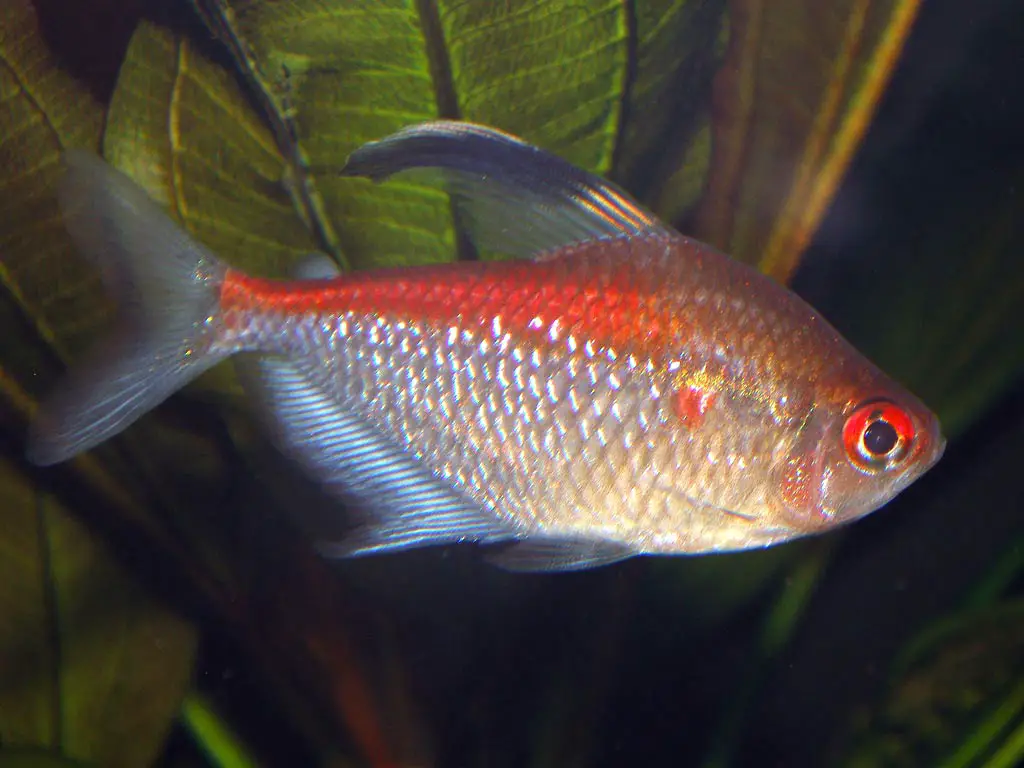
Availability Of Bleeding Heart Tetra
Now it seems like you have probably made up your mind about this beautiful tetra, so let’s talk about where to find them and whether it easier or not.
The bleeding heart tetra resides on the densely vegetated tropical freshwater rivers and streams. You can find them around South America and Brazil in the Amazon River and the Rio Negro.
The bleeding heart tetra is not on the red list, so you can find them in the wild. Also, these tetras are widely bred in the aquarium due to their rising popularity.
See you are here, aren’t you? Quite a Fan?? Thanks to the breeders for making it possible to get these bleeding hearts easily.
These tetras are readily available at reasonable prices in various pet stores and online stores as well.
Bleeding Heart Tetra Lifespan
In the wild, Bleeding Heart Tetra has a lifespan of about 10 years. However, those that are kept in captivity (i.e. your aquarium) have a lifespan of about 5 years. If you regularly maintain your aquarium water parameter, these tetras might even live another year or so. Not that long, but will give you company and that’s what matters.
Bleeding Heart Tetra Price
Now coming to the budget plan, this will certainly finalize your decision to pet Bleeding Heart Tetras. The good news is the bleeding heart tetra is widely available across America and Europe with a minimum cost of less than $6 or £6.
Bleeding Heart Tetra fish can cost up to $4.29 in the USA whereas it is slightly costly at £5.40 across various regions of the UK.
As the fish needs to be kept in a group of at least 6, you will be spending at least $25, this one will fit right into your budget plan.
Fish Keeping Difficulty
Bleeding hearts are mostly very peaceful and are not even slightly aggressive as other tetras. Hence, they are ideal for beginners with a community tank.
You can mix them with other tetra fish like glowlight tetra, neon tetra, cardinal tetra in your community tank.
However, the male fish can get territorial and when this happens; fin nipping can become a problem. Moreover, do not keep them with fish with long fins such as betta, goldfish.
These fish are sometimes territorial, bully, and fin nippers at small and long-tail fish, and tend to harass other tank mates at times.
Likewise, Bleeding hearts do not adapt well to the continuous changes occurring in the tank. It can make them stress. Hence, You need to change and clean the tank water frequently.
Sexual Difference Between Bleeding Heart Tetra
The bleeding heart tetra has a splendid body shape. The male body has a length ranging from 29.1 mm to 60.6 mm whereas the females have body lengths ranging from 29.0 mm to 53.3 mm.
The female tetras are more full-bodied and have a shorter, rounded fin while the male bleeding heart tetra has more color and elaborate fins.
You can differentiate the gender of these tetras by looking at their dorsal and anal fin as the male has longer extended dorsal and anal fins as compared to the female.
The dorsal fin elongates into a type of sickle, arching to the length of the base of the tail. The dorsal fins of both male and female bleeding heart tetras are in black, pink, purple, orange, and white colors. It also has transparent fins.
Bleeding Heart Tetra Fish Care
Just like we humans require fresh air to breathe, fish also need a clean environment to thrive. So, if you wish for a good and healthy life for your fish maintain your aquarium water regularly.
Just like any other pets, fish also need proper care, grooming, and checking up on any minor changes in their environment.
Bleeding heart tetras being freshwater tetras are not difficult to care for and maintain like other fish. They are very easy to care for but it does not mean they are low-maintenance fish.
An aquarium is a small space for any fish to survive in, you can’t make it a prison for them. Fish are your friend, so treat them like one and please give them every little thing they ask for.
Tetra Fish might be hardy but these fish are your responsibility, so act like a good friend here. Treat them like any other living beings and look out for their inconveniences.
Let’s learn about the things you need to do for your bleeding heart tetra.
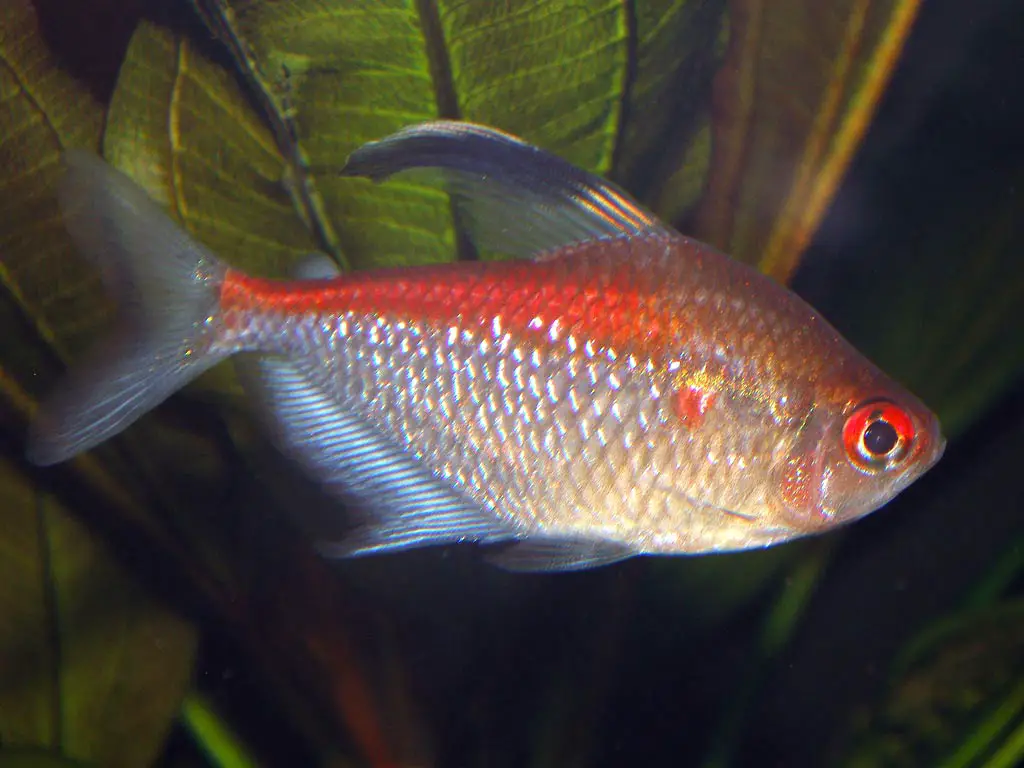
Tank Size For Bleeding Heart Tetra
Bleeding heart tetras, unlike most other smaller tetras, are demanding at times. The bleeding hearts are active swimmers so need somewhat open areas to help them swim freely.
Hence, the required tank size for bleeding hearts is at least 24 inches long with 15 inches in height, or simply a 15-gallon tank.


To get the best of bleeding hearts you need to keep them in a biotope tank that resembles their natural habitat.
The bleeding tetras are jumpers so their owners should secure the lid of the tank carefully. You will find them swimming mostly in the bottom and middle of the tank.
There is a slight possibility of them getting spooked with a minor change in the tank, so be careful.
Lightings For Bleeding Heart Tetra
The tetra family is a fan of dim lightings and bleeding heart tetras follow their family right behind. When you keep bleeding heart tetras in the dim-lit tank, you will see the difference yourself.
The colors of these tetras brighten and saturate making the aquarium very attractive and beautiful to look at. It can be intoxicating, no doubt or question there.
The bleeding hearts love the aquarium with dry leaves in the bottom of the tank. And hence this decoration supports and affects the lightings inside the tank.
NICREW ClassicLED Aquarium Light is an ideal choice for the aquarium with these tetras demanding low output.
Decorations and Substrate
Heart tetra bleeding favors a cover of the plant and darker gravel. Another tetra that prefers a well-planted aquarium and dark substrate is not that surprising, is it?
For the substrate, you can use river sand with some driftwood and twisted roots too. Additionally, you may also add some dried leaves to the sand to acquire light brown color water.
But remember to replace the leaves every few weeks as they decay and deteriorate the quality of the tank water.
Spectrastone Special Black Aquarium Gravel, go for this one for the darker and natural look for these cute tetras.
Seachem Flourite Black Clay Gravel can give your aquarium a natural look and porous substrate for plants to grow in.
Bleeding Heart Tetra Fish Diet
The bleeding heart tetras are very easy to feed and will eat anything you give them. A wide range of commercial fish products, including quality flakes, frozen or congelation-dried foods can be the diet of the bleeding heart tetra.
You can also add small live foods to its diet including bloodworms and brine shrimp and spirulina-bearing herbivore species.
Maintain Water Quality For Bleeding Heart Tetra
One of the major factors that decide whether your bleeding tetra will stay happy and healthy in the tank is water quality. These tetras might be hardy, but they need to have ideal water parameters in the tank.
They will adjust with the slightest fluctuation but consistency in the fluctuation is never a good idea, with any fish.
Mixing of different foods is very important for overall health, behavior, and color. And of course, the temperature, pH, and Hardness are the heroes here determining the health and survival of these tetras.
The constant change in these factors can bring subsequent issues in the tank as well as for your fish.
Bleeding Heart Tetra is as sensitive and delicate as any other fish, so it is quite necessary to maintain the ideal condition.
Here are the things you need to do for your bleeding heart tetras while maintaining the water parameters. Let’s get started with all the learning, shall we?
Temperature
Bleeding heart tetras are freshwater tropical fish so, they ask for the same temperature as their natural habitat. You need to find a way to keep the temperature of the tank at 22 °C (72°F) – 26 °C (79 °F).
Your best bet and solution to maintain the ideal temperature is to get an aquarium heater. Tetra HT Submersible is an ideal choice for the tetra tank, you can buy it easily from the nearest pet store or online.
Hitop Submersible Adjustable Aquarium Heater is also an option to choose from when it comes to aquarium heater in the tetra tank.
These heaters are automatic, meaning all you have to do is adjust temperature and they will do their job to maintain the water temperature that you have set. Easy, isn’t it?
pH and Hardness
The bleeding tetra fish, like most tetras, lives in the wild with a pH level between the range of 5.6 to 7.2.
They ask for nearly the same pH in the captivity to ranging between 6.5 to 6.8 hence the soft and acidic water. The hardness of the water in these tetras ask for is in the range of 3 to 12 dGH.
You need to have the FUNSW Aquarium Test Strips to monitor the change in the pH level and hardness of the aquarium water.
You can also use test kits like the API master test kit to check the water quality of the tank with bleeding heart tetra.
There are ways to maintain the aquarium pH and adjust it according to the fish you are planning to get.
Filtration
Filtration is the most important factor to determine the quality of water and tank for your bleeding heart tetras.
An aquarium is a closed environment where the fish lives as well as excretes. Due to this, pollution and harmful toxins develop within the tank due to ammonia production as well as ammonia poisoning.
To maintain the good health of the bleeding heart tetra, you must add a good quality filter in your tank.
A filter is a good addition to ensuring water quality. This device helps to remove the physical pollutants such as dead fish, leaves, and other waste materials from the tank.
Likewise, it also removes the chemical pollutants such as ammonia and nitrite from the tank. As the water in the tank ages, beneficial bacteria housed in filter media helps in Aquarium nitrogen Cycle.
The beneficial bacteria break down harmful chemicals into less harmful ones i.e., Ammonia to nitrites and nitrites to nitrate.
This will improve your water quality however, to remove nitrate you will need to replace your aquarium water with 10% fresh water every other day.
Penn Plax Cascade 400 Submersible Aquarium Filter is a highly recommended canister filter you can use in your tetra tank.
Aquarium water maintenance
We, humans, need fresh air to breathe and stay healthy. Likewise, fish needs a clean and pollution-free environment to flourish. Hence, for your fish to live a healthy life, you must maintain the aquarium water daily.
The owner must not ignore all the tell-tale signs that clearly show the aquarium needs cleaning.
Aquarium water becoming dirty, foamy, and cloudy or even the fish becoming sick is the clear sign you are being careless.
The fish are supposed to swim freely in the wild streams and it takes an extra effort to keep them comfortable in a small space such as in the aquarium tank.
Hence, you need to research and understand beforehand how difficult it to care for the fish then only pet one.
The water in the tank requires cleaning every week. Change about 20% of the tank water every week to maintain the chemistry of the water.
Fish Tank Mates
Bleeding heart tetras are peaceful and cooperative tetras. They are the schooling tetras and mostly shine when kept in groups of six.
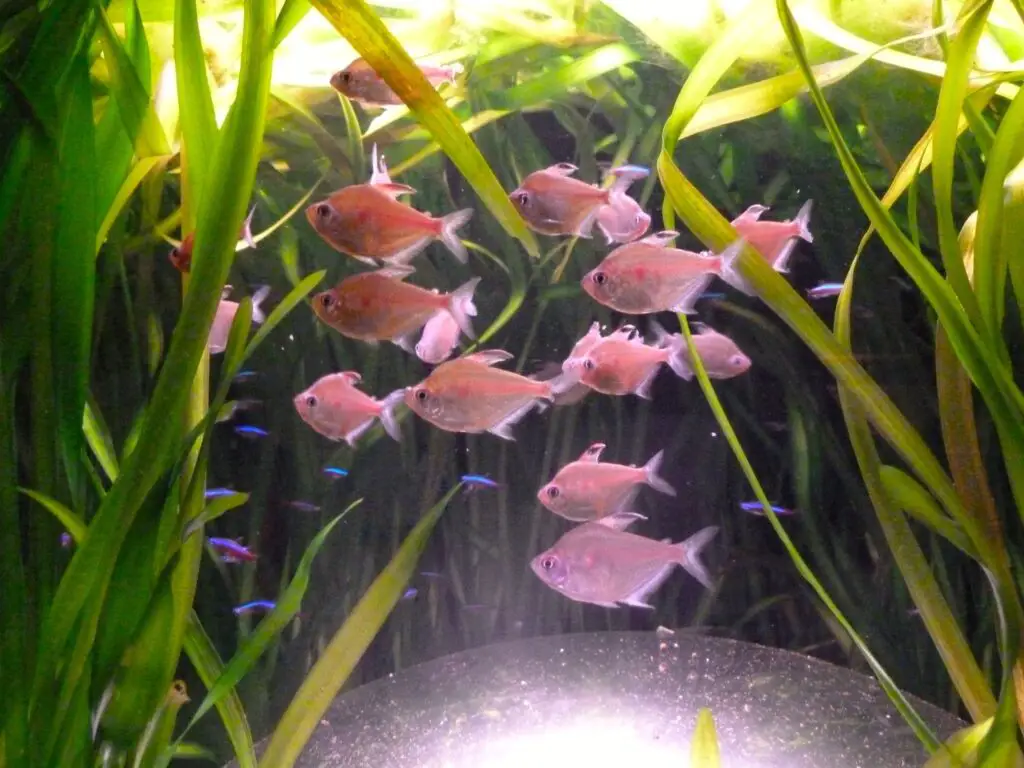
When kept with other varieties of tetras, they get to stand out as they have larger bodies in comparison to others.
Glowlight Tetra, Cardinal Tetra, and Neon tetra can be ideal tank mates for these tetras, as most tetras are compatible with each other.
Some of the smaller sized fish for the companion of bleeding heart tetras are Danios, cherry barbs, Rasboras, and some bottom dwellers such as some loaches or Cory.
However, the bleeding heart tetras do not prefer larger size fish, as they can get aggressive and territorial.
Not only that, the bleeding hearts cannot cope with the less active fish such as dwarf cichlids, different types of tetras, fast movements can cause them a lot of stress.
Bleeding Heart Tetra Fish Diseases
Your fish might be immune to most of the diseases, but a dirty tank with poor water quality will affect your fish no matter what.
The same is the case with Bleeding heart tetra. They are prone to any kind of tropical diseases that are common in other tetras.
Some of the most common diseases that the bleeding heart can face are:
- Skin flukes
- Parasitic infestations (protozoa, worms, etc.)
- Ichthyobodo infection
- Bacterial infections (general)
- Bacterial diseases
Since the fish is in the confined container, the owner must keep an eye on their dear pet. Bleeding Heart Tetra might lose their immunity with the slightest changes in the tank environment.
Bleeding heart tetras are very hardy and they are the least likely to catch any diseases. Nevertheless, there is no guarantee that the diseases will not outbreak.
The fish farms nowadays are home to most of the bleeding heart tetras. However, before reaching any pet stores or your aquarium, the breeders keep them in different community tanks.
Therefore, you must check and make sure that you can identify any signs of illness and treat the affected fish only.
Quarantine the new fish before adding them to the tank with already existing fish. And separate the sick fish as soon as you see any signs and symptoms. Look for the following Symptoms:
- Sluggishness
- Loss of appetite
- White spots
- Bottom Dwelling, etc.
Conclusion
Briefly, Bleeding Heart Tetras are very interesting fish to keep for their beautiful colors and active behavior. This article hopefully, provides you the basic guide for beginners to be able to keep these tetras as a pet. But people mostly get the fish in the tank and forget about it and let go of the responsibility.
Anyone can successfully keep bleeding heart tetras as pet fish by paying a bit more attention to them. The aquarium will be more attractive with these beautiful, active, and unique bleeding heart tetras.
Don’t worry and follow each step carefully and you’ll do just fine. And if you still have some queries or questions, the comment box below is always free and open for you.
Drop your questions or issues, I’ll try to help you or we can tackle the problem together.
Good Luck!
Happy Fish Keeping!!!
